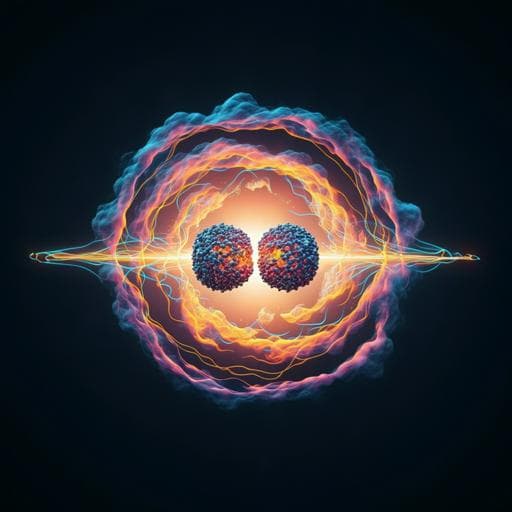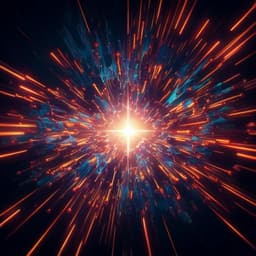
Physics
Filming movies of attosecond charge migration in single molecules with high harmonic spectroscopy
L. He, S. Sun, et al.
This groundbreaking study led by Lixin He and colleagues reveals the intricate dynamics of electron migration in molecules, providing a fascinating look at how light-matter interaction drives these processes. By employing machine learning to analyze high-order harmonics from fixed molecules, they unveil swirling patterns of electron holes in N2 and CO2, marking a significant advance in our understanding of ultrafast electron dynamics.
~3 min • Beginner • English
Introduction
Understanding ultrafast electron and nuclear motion following light–molecule interaction is fundamental to chemical and biological processes. Attosecond techniques combining XUV and IR pulses (e.g., transient absorption, streaking, mass/ion spectroscopy) have enabled observation and partial control of electronic dynamics, but direct, attosecond-resolved "charge migration" as defined by Cederbaum (field-free electronic wavepacket evolution after sudden ionization) has remained challenging due to limited temporal resolution in conventional pump–probe schemes. Laser-induced electron diffraction (LIED) and high-harmonic spectroscopy (HHS) exploit the recollision mechanism to probe structure and dynamics with sub-ångström spatial and attosecond temporal resolution via time–frequency mapping of harmonic emission. Prior HHS work reported charge migration in HCCI, but rigorous reconstruction is an ill-posed inverse problem requiring robust scattering theory and deconvolution of ensemble angular averaging to access single-molecule phases and amplitudes. Since measured harmonics are coherently averaged over imperfect alignment distributions, direct use of angle-averaged spectra compromises phase information central to electron wavepacket dynamics. This work addresses these issues by retrieving fixed-in-space single-molecule complex dipoles and multichannel (multi-orbital) populations/phases using additional constraints from two-color HHG and machine learning, enabling the construction of attosecond “movies” of laser-driven charge (hole) migration in N2 and CO2 with full angular dependence.
Literature Review
The study builds on: (a) foundational attosecond pulse generation and metrology; (b) pump–probe attosecond spectroscopy techniques (XUV transient absorption, streaking) for electronic dynamics; (c) LIED and HHS for structure and dynamics via electron recollision; (d) multichannel HHG theory and experiments showing contributions from multiple orbitals (e.g., HOMO and lower-lying orbitals) and alignment dependence; (e) previous demonstration of laser-driven charge migration via HHS in HCCI (Kraus et al., 2015), highlighting challenges of inverse reconstruction; and (f) quantitative rescattering (QRS) theory to calculate HHG responses. The paper also references rotational alignment spectroscopy to determine angular distributions, and discusses how angular averaging corrupts phase retrieval in prior HHS studies. It leverages machine learning (sparse representation, LASSO) and genetic algorithms to solve ill-posed inversion and multichannel decomposition, and validates reconstructed parameters against TDDFT simulations.
Methodology
Overview: The authors reconstruct molecular-frame, single-molecule complex dipole moments D(ω,θ) and multichannel ion-state populations/phases from alignment-dependent HHG measurements, combining one-color and parallel two-color driving fields and machine learning-based inversion. They then map harmonic orders to recombination (excursion) times to assemble time-dependent hole densities and fluxes, producing attosecond-resolved movies of laser-driven charge migration.
Experimental setup: A Ti:sapphire system (35 fs, 800 nm, 1 kHz) provides an alignment pulse (moderate intensity) and a probe pulse (either one-color 800 nm or two-color consisting of the fundamental plus a weak second harmonic, SH). Polarizations are parallel. A motorized delay line controls alignment–probe delay. Pulses are focused by an f=250 mm mirror to a supersonic gas jet (backing pressure 0.8 bar), placed 2 mm after focus for short-trajectory phase matching. High harmonics are detected with a flat-field soft X-ray spectrometer. Time-dependent harmonic signals are recorded versus alignment delay (one-color) and versus alignment delay and two-color relative phase (two-color). Molecular angular distributions p(θ,τ) are determined following a published method. Alignment-dependent HHG spectra are collected for selected harmonic orders (including even and odd harmonics in two-color driving) for N2 and CO2.
Signal model and single-molecule dipole retrieval (Step 1): For parallel pump–probe polarizations, the ensemble HHG signal for a given harmonic order is S(ω,τ)=|∫D(ω,θ)p(θ,τ)sinθ dθ|. Because molecular alignment is imperfect, S is a coherent convolution of single-molecule dipoles D with the time-dependent angular distribution p. The inverse problem to retrieve angle-resolved D(ω,θ) (amplitude and phase) from measurements is nonlinear and ill-posed. The authors reformulate S in terms of a kernel R(θ1,θ2)=Re[D*(ω,θ1)D(ω,θ2)] and p(θ1,θ2,τ)=p(θ1,τ)p(θ2,τ)sinθ1 sinθ2, discretize angles, and express S(τ) as a bilinear form over R and p. They apply a sparse-representation machine learning method: expand R in a 2D Legendre polynomial dictionary and solve for expansion coefficients using LASSO regression, minimizing the l1 norm under data fidelity to reconstruct R. From R they retrieve amplitude and phase of D(ω,θ). This is performed for each harmonic order and, in two-color experiments, for multiple relative phases α to obtain D(ω,θ;α).
Multichannel decomposition (Step 2): The total single-molecule dipole is a coherent sum over ionization–recombination channels i (molecular ion states/orbitals): D(ω,θ)=Σi Di(ω,θ). For an initially populated state i, Di(ω,θ)=dion_i(ω,θ) a(ω) drec_i(ω,θ). The laser field can mix ion states between ionization and recombination, described by coefficients Cij(θ), leading effectively to D(ω,θ)=Σi Ci(θ) Di(ω,θ) for the most relevant states (N2: X and A; CO2: X, A, B). The weak SH in two-color driving modulates even/odd harmonic phases and intensities without significantly altering dynamics; thus Ci(θ) are assumed independent of α. Using D(ω,θ;α) retrieved at multiple α, the authors solve for complex Ci(θ) with a genetic algorithm. Alignment-angle-dependent ionization rates ηi(θ) (for initial populations) are calculated via MO-ADK; consistency is checked with TDDFT simulations of populations and phases.
Time–frequency mapping and movie construction: Each harmonic order corresponds to a recombination (excursion) time from ionization to recollision. By using both odd and even harmonics from the two-color field, the effective time sampling is 50 as (versus ~100 as with odd-only), enabling accurate interpolation to 10 as steps. The complex wavepacket is assembled from the reconstructed channel populations and relative phases across harmonic orders and angles, yielding time-dependent hole densities (modulus square) and probability currents. Charge flux across planes (e.g., x=0, y=0) is computed from continuity to quantify migration.
Validation and analysis: The reconstructed channel populations and relative phases for N2 (X and A) and CO2 (X, A, B) at multiple alignment angles are compared with TDDFT under experimental conditions, showing reasonable agreement. Angular dependence and multiorbital contributions are analyzed (e.g., in N2, HOMO-1 contributes strongly at anti-alignment, affecting higher-order harmonics).
Key Findings
- Successful retrieval of fixed-in-space single-molecule complex dipoles D(ω,θ) (amplitude and phase) from alignment-dependent HHG, overcoming angle-averaging artifacts via ML-based deconvolution.
- Multichannel decomposition yields time-dependent populations and relative phases of molecular ion states (N2+: X and A; CO2+: X, A, B) for specific alignment angles at recombination times mapped to harmonic orders.
- Construction of attosecond “movies” of laser-driven hole (charge) migration with effective 50 as sampling (even+odd harmonics) and interpolation to 10 as steps, capturing sub-ångström electron dynamics.
- CO2: pronounced hole migration and counterclockwise swirling dynamics around atomic centers when aligned parallel to the laser polarization; flux across x=0 and y=0 planes varies rapidly on attosecond timescales, indicating multidirectional migration rather than simple drift along polarization.
- N2: due to orbital symmetries, hole densities remain symmetric about x=0; minimal migration at 0° and 60°; enhanced dynamics at 90° where HOMO-1 contributes more strongly; flux across x=−1.5 a.u. and y=0 planes reflects the time-dependent behavior.
- Angular dependence fully resolved: different alignment angles produce distinct migration patterns and flux signatures in both molecules.
- Inclusion of two-color driving halves the time step between mapped recombination instants (from ~100 as to ~50 as at 800 nm), significantly improving temporal resolution and interpolation accuracy.
- Reconstructed parameters (populations and phases) show reasonable agreement with TDDFT calculations under experimental conditions.
- Demonstration that direct reconstruction from ensemble-averaged spectra can lead to large errors; proper single-molecule retrieval is essential for accurate dynamics.
Discussion
The work addresses the long-standing challenge of directly measuring attosecond charge migration by resolving the single-molecule, angle-dependent complex HHG dipoles and disentangling multiorbital contributions. By combining ML-based inversion of alignment-dependent HHG with two-color constraints, the authors preserve phase information otherwise lost in ensemble averaging, enabling reconstruction of molecular-frame electron dynamics. The resulting movies show that laser-driven charge migration is not confined to simple axial motion along the polarization but can swirl around atomic centers, emphasizing the role of multichannel interference and alignment. The findings validate HHS as a quantitative probe of ultrafast, sub-ångström electron dynamics and demonstrate that field-driven charge migration proceeds faster than field-free evolution, consistent with driven two-level dynamics. The approach generalizes to other systems provided sufficient spectral–angular data are available, and sets a benchmark for incorporating rigorous single-molecule deconvolution in gas-phase ultrafast measurements.
Conclusion
The study introduces a robust, ML-assisted HHS framework to retrieve fixed-in-space single-molecule complex dipoles and multichannel dynamics, enabling high-fidelity movies of laser-driven charge migration with attosecond temporal resolution and molecular-frame angular specificity. Applied to N2 and CO2, the method reveals pronounced, angle-dependent hole migration, including swirling motion, and quantifies dynamics via flux analysis. The approach is general and can be extended to other molecules and ultrafast measurements, though practical limits arise as the number of contributing orbitals increases and more data are required. Future directions include extending the time window using longer-wavelength drivers to capture nuclear–electronic coupling at later times, applying the method to more complex molecules (e.g., rings) to identify new migration pathways, and integrating single-molecule retrieval into related ultrafast spectroscopies (tomography, time delays, photoelectron momentum imaging).
Limitations
- Ensemble alignment is imperfect; measured HHG requires deconvolution to recover single-molecule phases and amplitudes—omitting this step leads to significant errors.
- Reconstruction is an ill-posed inverse problem requiring strong priors and ML regularization; accuracy depends on data quantity/quality and model assumptions.
- Two-color SH field is weak to avoid perturbing dynamics, limiting signal strength of even harmonics; assumption that dynamics are α-independent may break at higher SH intensities.
- Temporal window is limited by the excursion times of accessible harmonic orders with 800 nm (≈0.94–1.5 fs); extending requires longer-wavelength drivers.
- Field-driven charge migration differs from field-free dynamics; few-cycle drivers could reduce field influence but complicate time–frequency mapping due to broader spectra.
- Scalability: as the number of contributing orbitals (channels) grows, the parameter space enlarges and substantially more experimental data are needed for reliable retrieval.
- Molecular-frame ionization rates are modeled (MO-ADK); inaccuracies in these rates can affect extracted initial populations.
Related Publications
Explore these studies to deepen your understanding of the subject.







